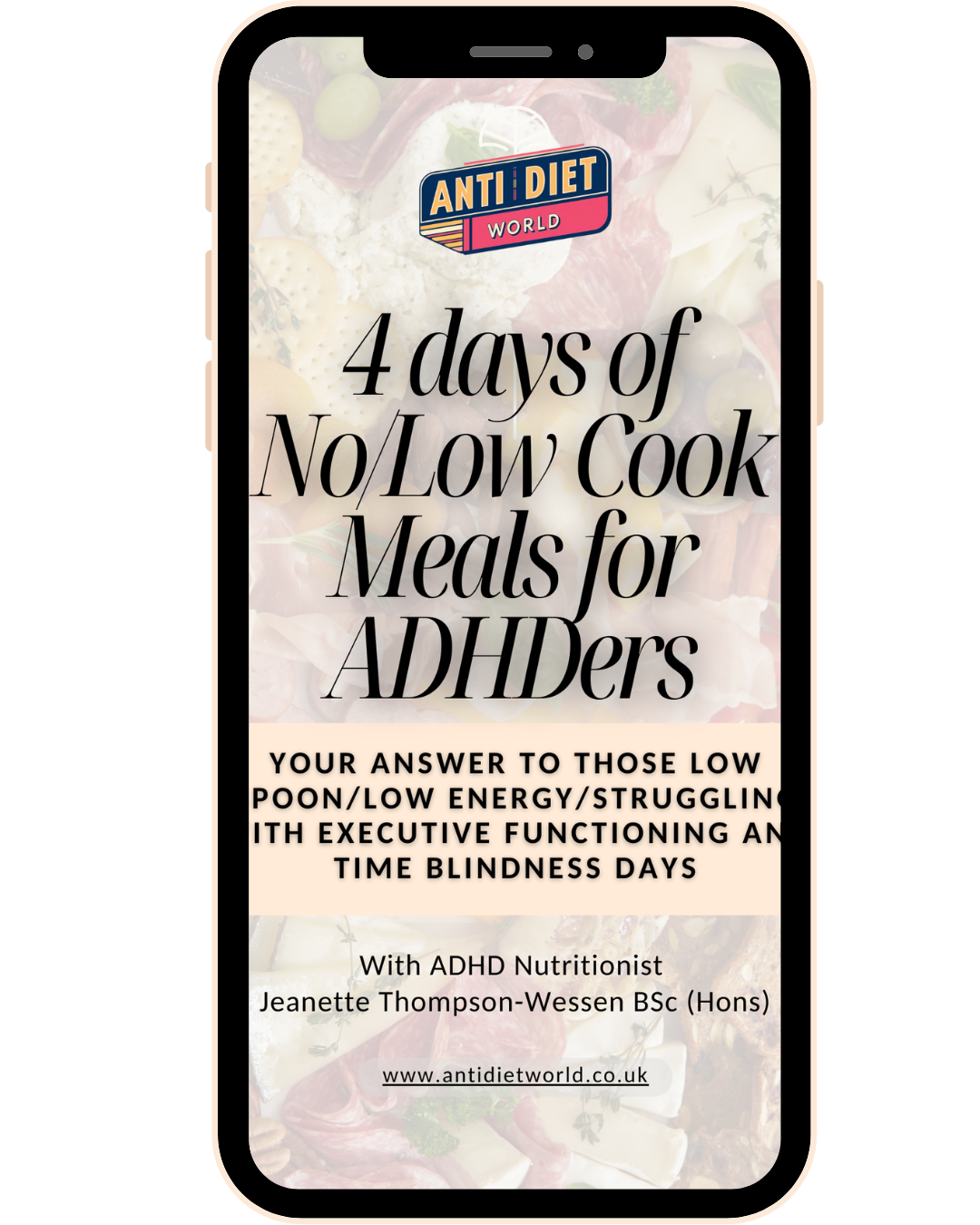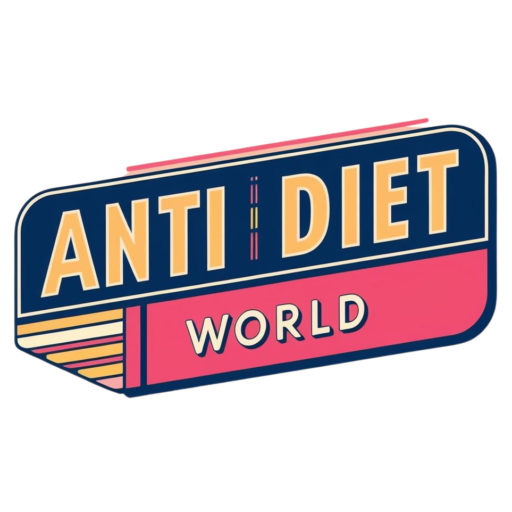An Anti-Diet, Fat-Positive ADHD Guide to Eating
If you have ADHD, eating regularly can feel like a full-time job. One minute you’re deep in hyperfocus, and the next, you realize it’s 5 p.m., you haven’t eaten all day, and you’re ready to devour everything in sight. Or maybe you stare at your fridge, overwhelmed by the sheer number of choices, and decide to just… not eat. Sound familiar?
ADHD brings a whole set of challenges to eating—executive dysfunction, decision paralysis, sensory sensitivities, time blindness, and dopamine-driven eating, just to name a few. Add diet culture into the mix, telling you what you should be eating (and how much and when and in what way), and suddenly, food becomes even more stressful.
This guide is here to help. No guilt, no restriction, no unrealistic meal plans—just real, ADHD-friendly strategies that make eating easier, all through an anti-diet, fat-positive, and intersectional feminist lens.
Why Eating Feels So Hard with ADHD
ADHD messes with executive function—aka the brain’s ability to plan, organise, and follow through on tasks (Barkley, 2015). Since eating requires all of those skills, it makes sense that so many ADHDers struggle with it.
Time blindness can mean hours pass without you realising you haven’t eaten. Decision paralysis makes even the most stocked fridge feel empty because the mental effort of picking something is exhausting. Dopamine-driven eating means certain foods might feel irresistible while others seem like a chore. Sensory sensitivities can make textures or flavors unbearable, even if they were fine yesterday. On top of that, diet culture pushes restrictive food rules that make eating even harder, leading to guilt, shame, and cycles of bingeing and restriction (Tribole & Resch, 2020).
ADHD-Friendly Ways to Make Eating Easier
Eating Regularly When You Forget to Eat
Skipping meals can make ADHD symptoms worse—hello, brain fog, irritability, and impulse eating (Gilsenan et al., 2009). But hunger cues aren’t always reliable, and getting distracted is almost inevitable. That’s where structured support can help. Using external reminders, like setting phone alarms or associating meals with daily routines, can make a huge difference.
For example, if you tend to hyperfocus on work, setting an alarm to check in with yourself every few hours can act as a prompt. If mornings are rushed and you always forget breakfast, pairing it with something you already do—like eating while waiting for your coffee to brew—can help build consistency.
Leaning Into Dopamine-Seeking Eating
Instead of fighting your brain’s need for stimulation, you can make eating more engaging. If food feels boring, it’s easy to put off meals until you’re starving. Finding ways to add novelty can make meals more appealing.
One approach is focusing on visual appeal, like plating food in a way that’s fun and colorful. If textures are important, adding crunch to meals with toppings like nuts or seeds can make eating more enjoyable. A client once struggled with eating because food felt monotonous, but when they started rotating different sauces and seasonings, meals felt fresh and exciting again.
Reducing Decision Paralysis Around Meals
Too many choices can lead to shutdown, making it easier to just not eat. Instead of deciding what to eat in the moment, having a simple framework can cut through the overwhelm.
For example, using the “protein + carb + fat” framework takes the pressure off decision-making. Instead of planning full meals, you can think, “Okay, I need a protein, a carb, and a fat—what’s easiest right now?” That might mean grabbing cheese, crackers, and a handful of nuts instead of feeling stuck on whether to cook a full meal.
Some ADHDers find that batch-prepping meal components instead of full meals makes eating easier. A person who felt overwhelmed by meal prep started keeping cooked rice, chopped veggies, and marinated tofu in the fridge. When it was time to eat, they could mix and match without overthinking.
Making Food More Accessible
Out of sight is often out of mind with ADHD, so keeping food visible and easy to access makes a huge difference. Moving snacks to eye level in the fridge or keeping a stash of pre-cut fruit on the counter means you’re more likely to eat when you need to. If opening packaging feels like a barrier, transferring foods into easy-to-grab containers can help.
One person I worked with always forgot about leftovers, leading to skipped meals and food waste. When they started using clear storage containers and labeling them with the day they should be eaten, they found it easier to grab meals without effort.
Challenging Diet Culture’s Food Rules
Diet culture loves to tell ADHDers that their eating is “bad” and they should be eating in a more “disciplined” way. But the reality? Restriction just leads to more bingeing, guilt, and stress (Tribole & Resch, 2020).
You don’t need to “fix” your eating—you need strategies that support your actual life. There are no “bad” foods, only food that meets your needs in different ways. If you’ve been conditioned to ignore hunger or feel guilty for eating “too much,” breaking those patterns takes practice. Giving yourself permission to eat—without judgment—is a key part of making food easier and more sustainable.
Ultimately Eating Should Work for You and Your ADHD
ADHD brains aren’t broken, and neither are your eating habits. You just need approaches that make eating easier, not harder. Ditch the guilt, embrace what works for you, and know that your body deserves nourishment—whether that’s a full meal or a handful of crackers and cheese.
If you want more support with ADHD-friendly eating, meal planning, or breaking free from diet culture, check out Easier Eat with ADHD, my 1:1 program designed to help ADHDers build realistic, sustainable eating habits—without restriction or shame.
References
Barkley, R. A. (2015). Attention-Deficit Hyperactivity Disorder: A Handbook for Diagnosis and Treatment. Guilford Press.
Brown, T. E. (2013). A New Understanding of ADHD in Children and Adults: Executive Function Impairments. Routledge.
Cherkasova, M. V., et al. (2021). “Reward sensitivity in ADHD: A meta-analysis.” Neuroscience & Biobehavioral Reviews, 122, 145-167.
Davis, C., et al. (2021). “The association between ADHD and disordered eating behaviors: A systematic review and meta-analysis.” Appetite, 157, 104994.
Farshchi, H. R., et al. (2004). “Effects of breakfast on cognitive performance, appetite, and metabolic markers.” The American Journal of Clinical Nutrition, 79(3), 361-368.
Gilsenan, M. B., et al. (2009). “Effects of breakfast size on cognitive performance, mood, and satiety.” Physiology & Behavior, 98(1-2), 51-57.
Tribole, E., & Resch, E. (2020). Intuitive Eating: A Revolutionary Anti-Diet Approach. St. Martin’s Essentials.
Wansink, B., et al. (2006). “Mindless eating: Why we eat more than we think.” Appetite, 47(2), 202-203.

